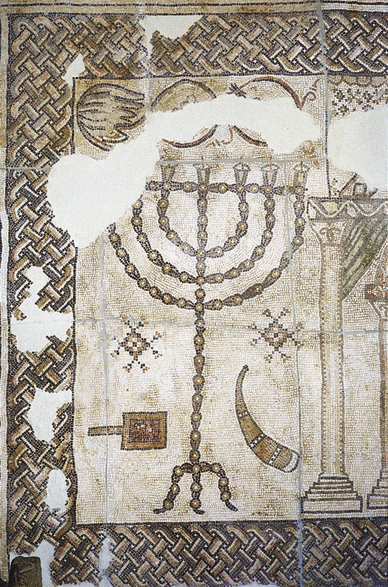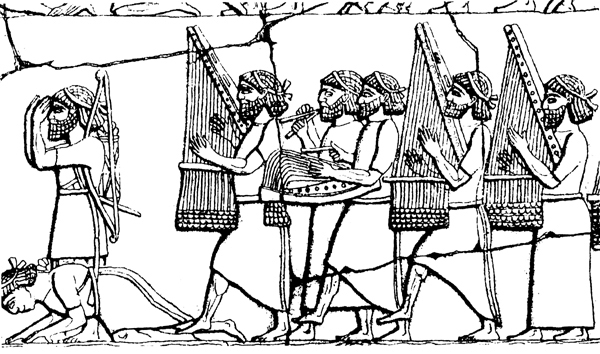
The text itself is music. Like a refrain, the litany of instruments is repeated four times in chapter 3 of the Book of Daniel: “the cornet, flute, harp, sackbut, psaltery, and dulcimer, and all kinds of musick.” Like an insistent ostinato, the names Shadrach, Meshach and Abed-Nego—the three young Hebrew exiles who will be fed to the “fiery furnace”—are repeated 13 times in the same chapter. The introduction and coda—twice at the beginning and once at the end—are “the satraps, the administrators, the governors, the counselors, the treasurers, the judges, the magistrates, and all the officials of the provinces,” who are called together to hear the decree of King Nebuchadnezzar of Babylon. Anyone who fails to bow down to the king’s golden statue at the sound of the orchestra will be thrown to the flames, the king’s herald declares. Of course, you know the rest: The three Hebrews—Shadrach, Meshach and Abed-Nego—refuse to bow down, so they are tossed into the fire with their clothes on. But they remain unscathed: Not “a hair of their heads” is singed! Thus Nebuchadnezzar learns a little respect for the God of Shadrach, Meshach and Abed-Nego.
For sheer poetic beauty, it is difficult to surpass the 17th-century King James Version (also known as the Authorized Version), quoted above. Yet just what does this musical passage tell us about the orchestra that Nebuchadnezzar assembled?

Any study of these instruments must address two issues: First, the King James translators had a difficult time determining what instruments were meant by the original Aramaic text (Daniel, unlike most of the Hebrew Bible, is partly written in Aramaic). Second, a modern reader will have difficulty understanding what instruments the King James translators were referring to because some of the same terms are used for very different instruments today.
Take, for example, the cornet of the King James Version, which is a translation of the Aramaic term qeren. Today a cornet is a small brass trumpet, popular among military bands. But that’s not what the King James translators had in mind: In the 16th to 17th century, the cornet was usually a curved, horn-shaped instrument. Some were carved from wood and covered with leather; others were made of ivory.1
The translators’ use of the word “cornet” suggests that they were aware of the base meaning of the word: The English “cornet” is derived (via French) from the Latin cornu, which means “horn.” (In modern translations, qeren is usually translated as “horn”; see the sidebar to this article.) The word qeren occurs frequently in the Hebrew Bible, usually in reference to the horn of an animal, such as a goat, rather than a musical instrument. Shofar (ram’s horn) most commonly fills that function, but that both shofar and qeren had the same meaning in early Hebrew is clear from the passage in Joshua that describes the fall of Jericho. There the priests are commanded to blow ram’s-horn trumpets: “So the people shouted when the priests blew with the trumpets and it came to pass…that the wall fell down flat” (Joshua 6:20). Shofar is used in Joshua 6, verses 4, 6, 8, 13 and 20, but qeren is used in verse 5. This shows that the qeren was known as a musical instrument at an early date.


Which brings us to the question of the date of the Daniel story. Many modern commentators argue that the book is a product of the second century B.C., but this is not a universally held view. While the text has probably suffered from scribal errors in transmission and we do not have it precisely as originally written, I believe there are reasonable grounds for dating the original composition as early as the fifth or even the late sixth century B.C., not long after the reign of Nebuchadnezzar (605–562 B.C.). In looking for the instruments that are indicated in the biblical text, we may therefore consider instruments known in the sixth and fifth centuries B.C.
Let’s move on to the flute—as the translators rendered the Aramaic term mashroqi. The flute used at the time of the King James translation was not unlike that of today; the instrument was made of wood or ivory, rather than metal, but it still consisted of a long narrow tube that was closed at one end and had finger holes. The sound was produced by blowing across a hole near the closed end of the tube.
The authors of the biblical text themselves may not have recognized these instruments, as is indicated by the fact that they spelled this word in more than one way (sabk and sŒabk, with a different s) in the same episode. This uncertainty about the spelling indicates that it is not an Aramaic term but a foreign loanword, very probably related to the Greek sambukeµ. Since this in its turn is regarded as a loanword in Greek (that is, it is not native Greek), it is possible that both sabk and sambukeµ derive from a common, third source. In the Septuagint, the third-century B.C. Greek translation of the Hebrew Bible, sabk is indeed translated into Greek as sambukeµ, showing that in the Hellenistic period the translators were aware of the similarity. The use of sambukeµ in Greek, however, does not shed much light on the meaning of sabk. The word is used in military contexts to refer to some kind of siege engine, perhaps as a sort of barrack-room joke. These jests suggest that the sambukeµ had a triangular shape. At the same time, references in musical contexts mention strings, sometimes “many strings,” and indicate that the instrument had a high pitch. So some kind of small harp is a reasonable guess.


Artistic representations show that the Greeks had at least four types of lyre: the lyra (with a small tortoise shell as the sound box), the barbitos (with longer arms and a larger tortoise shell as the sound box), the kithara (an elaborate wooden instrument, sometimes richly decorated) and a smaller wooden instrument, often used by women, for which the ancient name is not known.
from about the fifth century B.C. Although the lyres are not actually being played, they are clearly depicted in the same scene.4
These images suggest that Nebuchadnezzar’s orchestra may well have had two different kinds of lyre—a kithara and some other kind.
.
In the fifth century the word is mentioned by the poet Pindar and the playwright Euripides.12
Tambours (like tambourines without the jingles) (see eighth-century relief from Karatepe, Turkey) are well attested in Attic red-figure vase paintings of the fifth century B.C., so this is a possibility.13
MLA Citation
Footnotes
During the seventh to fifth centuries B.C., Greek vases were generally decorated with black figures on a lighter background. During the Attic period (fifth to fourth century B.C.), however, the natural red terra-cotta of the vase was left exposed for the figures, and the background was painted black.
Endnotes
Mary Remnant, Musical Instruments of the West (New York: St. Martin’s Press, 1978), p. 138 and figs. 119.5–9.
See Terence C. Mitchell, “The Music of the Old Testament Reconsidered,” Palestine Exploration Quarterly 124 (1992), p. 137.
See, e.g., John Boardman, Early Greek Vase Painting: 11th-6th Centuries B.C.—A Handbook (London: Thames and Hudson, 1998), figs. 99, 105, 131, 145.
See Martha Maas and Jane M. Snyder, Stringed Instruments of Ancient Greece (New Haven: Yale Univ. Press, 1989), p. 74, fig. 7; pp. 102–111, figs. 5, 6, 11, 17, 26; p. 134, fig. 11.
See Austen Henry Layard, Monuments of Nineveh, 2nd ser. (London: John Murray, 1853), pl. 49; and Discoveries in the Ruins of Nineveh and Babylon (London: John Murray, 1853), pp. 454–455, p. 454 n.
See, e.g., Remnant, Musical Instruments of the West (London: Batsford, 1978), p. 177; see also, conveniently, The Century Dictionary, rev. ed., 10 vols. (London and New York: The Century Co., 1899), vol. 7, p. 5337, with an illustration from a Persian painting (this dictionary was edited by the great Yale Sanskrit scholar William Dwight Whitney).
The illustration appeared in George Rawlinson, The Five Great Monarchies of the Ancient Eastern World, 2nd ed., 3 vols. (New York: Dodd, Mead, & Co., 1881), vol. 1, p. 538; and Carl Engel, The Music of the Most Ancient Nations, Particularly the Assyrians, Egyptians and Hebrews (London: J. Murray, 1864).
In Mitchell and Ray Joyce, “The Musical Instruments in Nebuchadnezzar’s Orchestra,” in D.J. Wiseman, ed., Notes on Some Problems in the Book of Daniel (London: Tyndale Press, 1965), pp. 19–27, at pp. 25–26.
Conveniently quoted in Andrew Barker, Greek Musical Writings, vol. 1, The Musician and His Art (Cambridge: Cambridge Univ. Press, 1984), pp. 59–60, 74–76, 88.
E.g., in Boardman, Athenian Red Figure Vases: The Classical Period—A Handbook (London: Thames and Hudson, 1989), pls. 177, 229, 285, 294, 324; see also, in general, Martin Litchfield West, Ancient Greek Music (Oxford and New York: Clarendon, 1992), p. 124; Mitchell, “Music of the Old Testament,” p. 137.





